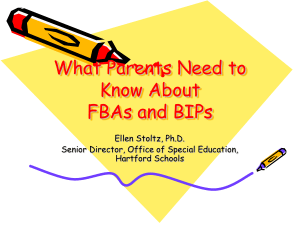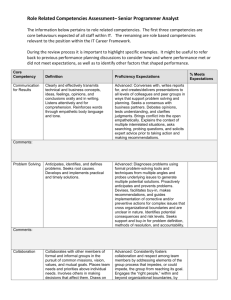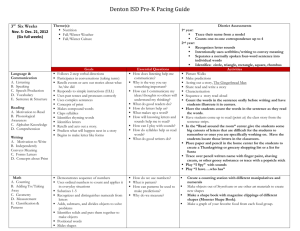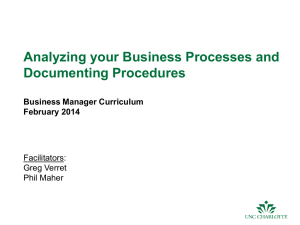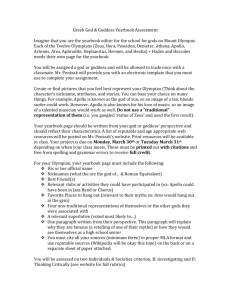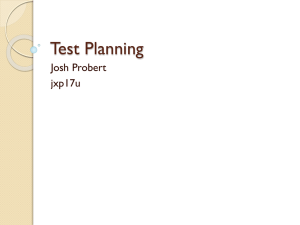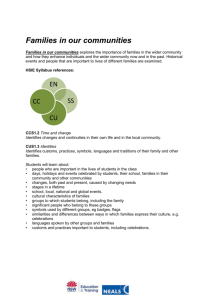Change over time - Curriculum Support
advertisement
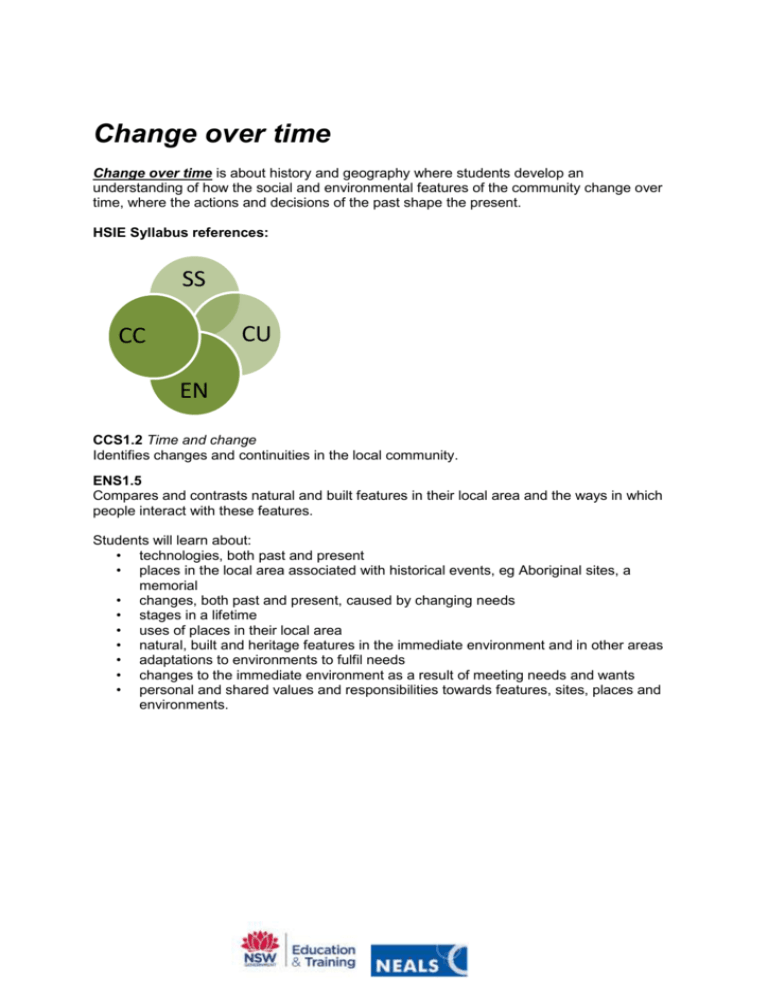
Change over time Change over time is about history and geography where students develop an understanding of how the social and environmental features of the community change over time, where the actions and decisions of the past shape the present. HSIE Syllabus references: SS CU CC EN CCS1.2 Time and change Identifies changes and continuities in the local community. ENS1.5 Compares and contrasts natural and built features in their local area and the ways in which people interact with these features. Students will learn about: • technologies, both past and present • places in the local area associated with historical events, eg Aboriginal sites, a memorial • changes, both past and present, caused by changing needs • stages in a lifetime • uses of places in their local area • natural, built and heritage features in the immediate environment and in other areas • adaptations to environments to fulfil needs • changes to the immediate environment as a result of meeting needs and wants • personal and shared values and responsibilities towards features, sites, places and environments. Teaching and learning Evidence of achievement Personal timelines • Introduce literary texts that illustrate personal heritage through common events changing over time e.g. When Frank was four by Alison Lester - discuss when the events in the text occurred - refer to specific words related to time and place in the story; develop a word bank of references to words and phrases related to personal and family heritage and the past. • Students relate experiences the character(s) had to their personal experiences. • Represent the events in the text as a time line using textual and visual clues e.g. Worksheet 8, p. 45 in Treasures. CCS1.2 Identifies changes and continuities in the local community • develops language associated with time and place • identifies personal experiences related to different ages. (Literacy link: relates own experiences to books read and identifies language of time and place) • Model the drawing of a timeline on the board to show year of birth and each year to the present. Locate some well known events on the time line, e.g. starting school, the birth of siblings, special holidays (family and community), moving house. • Students draw a personal timeline to show how old they were each year e.g. 2005 Born 2006 1 year old 2007 2 years old 2008 3 years old 2009 4 years old 2010 5 years old 2011 6 years old • Students: - complete the timeline using individual photographs or drawings of themselves depicting each year of their life e.g. Worksheet 1, p. 37 or Worksheet 11, p. 48 in Treasures. • Take a digital photograph of each child in the class to include in a pictorial timeline. • Students sequence their set of photographs or drawings into chronological order creating a pictorial timeline. 2005 2006 2007 2008 2009 2010 2011 • Choose a student to recount an experience to the class and record the key events and language of time they use. • Describe themselves at different ages, identifying events that occurred at the time. Personal records of time, place and events • Read a text about how people’s lives have changed for different generations e.g. When I turned six by David Drew. • Discuss the events in the book and: - identify the time frame and relate to students, their parents and grandparents - compare how characters participate in the story to how CCS1.2 Identifies changes and continuities in the local community • uses historical language of time and change e.g. old, new, past, present • describes some ways in Teaching and learning Evidence of achievement the students and their families might have participated in these events - research other family members from different generations (such as parents and grandparents) and how their lives have changed over time e.g. the type of clothes people wore, the games played, the food they ate, what they did to entertain themselves, what was a ‘treat’ - complete a profile based on the events in the story that show the differences between generations, for example This is what we wore This is what we played This is how we got to school We enjoyed these treats When I turned 6 in 200___ When Mum/Dad turned 6 in 19___ When Grandma /Grandpa turned 6 in 19___ When Great Grandma/Pa turned 6 in 19___ Available as Worksheets 3 and 4, p. 40–41 Treasures Assessment strategy The teacher: • analyses students’ worksheet responses • analyses students’ verbal explanations of how the lives of different generations show change over time. Assessment criteria The student: • uses historical language of time and change e.g. old, new, past, present • describes some ways in which the lives of previous generations are different to their own • identifies how the clothes people wear have changed over time • identifies some of the games played by different generations. Preparation for next lesson: Ask students to talk to their parents, grandparents (and if possible great grandparents, some of whom may not have attended school) about how they got to school when they were the same age as the students are now. Organise a guest (preferably a grandparent or an older person who is a long term resident of the area) to visit the class to talk about what the school and the local area was like when they were the same age as the students. which previous generations lives are different to their own. Teaching and learning Evidence of achievement Collect images of the local area taken in different eras. Sources include the local library, council, historical society and a search using your suburb/town on the Picture Australia web site. Getting to school • Collect data and compile a picture graph of how students get to school e.g. walk, car, bus, bike. • Ask students how they think they would get to school when they are in Year 7. Do they think this will change from how they get to school now? Why? • Review the information collected on how parents, grandparents and great grandparents got to school when they were young. Ask: - how is this different to how students now get to school? - why has this changed? • Compile possible questions for the guest visitor about what life was like when they were younger e.g. clothing, travel, food (breakfast, lunch at school, birthdays), homework, school lessons, TV/computers, sport, entertainment, friends, how they had fun. Changes in the local environment • Ask the guest to identify changes that have occurred in the local environment since they were young, and record changes for future reference. The guest could refer to images collected and copies could be made of any images they have brought (with permission) and images sourced from Picture Australia web site • The teacher: - makes note of key points and answers to student questions - add captions to the collected images and display. • Ask: why do you think some of these changes occurred? • Review the images and captions with students, explain and discuss the changes that have occurred and some of the reasons for these changes in the local environment. Changes in Aboriginal communities • Choose a text that shows changes in Aboriginal communities over time e.g. A is for Aunty by Elaine Russell from ABC Books for the Australian Broadcasting Commission; My Country by Connie Ah See, in Caring for Place, Caring for Country (DET);Ten little Jarjum in Big mob books for little fullas (BOS). • Alternatively, older members of the Aboriginal community can talk to students about what their life was like as a child growing up. • During reading, use a simple retrieval chart of Then and Now e.g. A is for Aunty could include. Amend the retrieval chart to reflect the aspects of then and now referenced in the text. Then Billy carts Now Bikes and scooters CCS1.2 Identifies changes and continuities in the local community • identifies how students travelled to school in the past • listens and engages in discussion with community member about life in an earlier era. ENS1.5 Compares and contrasts natural and built features in their local area and the ways in which people interact with these features. • discusses the changes the local area over time • contributes some reasons for changes to the local area. CCS1.2 Identifies changes and continuities in the local community • engages in stories about change in Aboriginal communities • identifies changes in the way people live over time. ENS1.5 Compares and contrasts natural and built features in their local area and the ways in which people interact with these features • identifies ways people have changed the way Teaching and learning Fence – hand made from bush and wire Homemade marbles, dolly peg dolls, hopscotch Humpy Inspection day Mission Pet possum Quandong jam made in a big pot over the fire Swimming in the river Suppertime – cooking on the campfire Milking the cows Witchetty grubs and yabbies Evidence of achievement Fence – bought from a shop or built on site Computer games, (etc.) House Does not happen any more Does not happen any more Dog, cat Jars of jam from the supermarket Beach or pool BBQ Buying milk in bottles or cartons Buying meat from the supermarket or butcher • After reading, decide if changes between then and now are positive (good) or negative (bad) or interesting (neither positive nor negative). • Discuss how changes in lifestyle between then and now can affect the environment e.g. purchasing goods from supermarkets instead of milking cows in a paddock; enjoying home-made jam; pollution affecting the yabbies in the creek; indoor games and watching TV instead of running around and playing outside games. people have changed the way they have used the environment • discusses and decides if the changes to the environment are positive or negative. Teaching and learning Evidence of achievement Changes in our school environment This activity collects data on the management of the school grounds. The data collected by students could be included in the school’s environmental management plan. Refer to the DET Environmental Education Policy, and support documents for further information. The Stage 1 video on the Learnscapes (DET) CD-ROM, if available, demonstrates students undertaking a similar activity and could be viewed by the class as preparation for this activity. • Walk around the school to identify changes to the school environment that have occurred since students started school e.g. new lunch seats, trees planted, shade cloth replaced, a building painted, new building/s such as a demountable, vandalism, new gardens, erosion. • Discuss whether the changes are either positive or negative and give reasons. • Identify the type of ground cover in the different parts of the school. List the words used to describe the ground cover e.g. asphalt, concrete, grass, garden, driveway, footpath, mulch. Explain and illustrate words if necessary. ENS1.5 Compares and contrasts natural and built features in their local area and the ways in which people interact with these features. • examines the different ground covers and classifies as natural or man made • identifies changes to the school environment and classifies as positive or negative • outlines some positive changes that could be made to the school environment • draw and label a place in the school environment with suggestions for positive changes. Investigating the school environment • Use the list of ground cover words to develop a worksheet e.g. 1 (or 2, 3 etc.) - Name: asphalt concrete grass garden mulch footpath bare dirt • Organise students into groups of 4 or 5 students, identify students as 1, 2, 3, 4 or 5, to undertake a ‘police walk’ of the school grounds. • Start in a spread out line at one end of the school e.g. 1, 2, 3, 4, 5, 1, 2, 3 … Have all Student 1’s record what is underfoot onto their worksheet to tally what they see, then to take a step forward and record etc. Then do student 2’s. Repeat until all students have recorded ground cover walked over during the ‘police walk’. • Tally students’ results and construct a graph from the data. Identify the features as living or non living. Non living can be categorised into natural or manmade. Ask: - what is the most common ground cover? Is this a living or non living ground cover? - what are the good things? What are the bad things? Why? - what does the information displayed in the graph tell us about the school environment? How could it be improved Teaching and learning for the future? • Students draw and label a place in the school environment they would like to change. They could provide an oral explanation of the changes and the reasons for the changes. Assessment strategy The teacher: • observes students and evaluates their explanations. Assessment criteria The student: • examines the different ground covers and classifies as natural or man made • identifies changes to the school environment and classifies as positive or negative • outlines some positive changes that could be made to the school environment. Evidence of achievement
